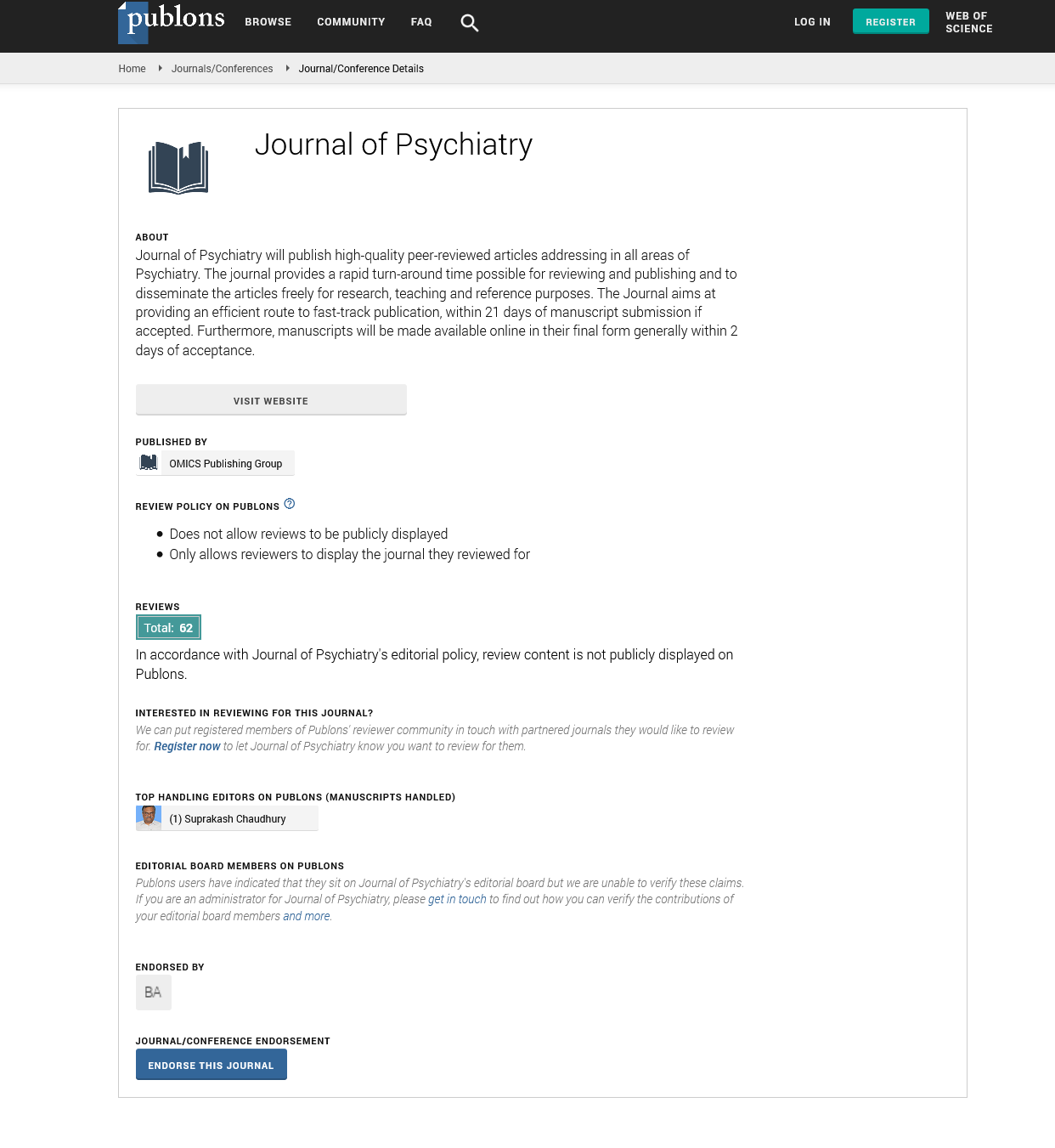Indexed In
- RefSeek
- Hamdard University
- EBSCO A-Z
- OCLC- WorldCat
- SWB online catalog
- Publons
- International committee of medical journals editors (ICMJE)
- Geneva Foundation for Medical Education and Research
Useful Links
Share This Page
Open Access Journals
- Agri and Aquaculture
- Biochemistry
- Bioinformatics & Systems Biology
- Business & Management
- Chemistry
- Clinical Sciences
- Engineering
- Food & Nutrition
- General Science
- Genetics & Molecular Biology
- Immunology & Microbiology
- Medical Sciences
- Neuroscience & Psychology
- Nursing & Health Care
- Pharmaceutical Sciences
Perspective - (2022) Volume 25, Issue 9
Examination and Diagnosis of Relative Importance of Various Clinical Features of Psychotic Major Depression (PMD)
Yongyun Zhao*Received: 01-Sep-2022, Manuscript No. JOP-22-18457; Editor assigned: 05-Sep-2022, Pre QC No. JOP-22-18457(PQ); Reviewed: 19-Sep-2022, QC No. JOP-22-18457; Revised: 26-Sep-2022, Manuscript No. JOP-22-18457(R); Published: 03-Oct-2022, DOI: 10.35248/2378-5756.22.25.531
About the Study
The prognosis is worse for the unique subtype of depression known as Psychotic Major Depression (PMD). Previous research did not uncover significant differences between patients with PMD and those with Schizophrenia (SZ) or Non-Psychotic Major Depression (NPMD). This study examined the sociodemographic variables (including the season of conception) and clinical traits of psychotic major depression with non-psychotic major depression, schizophrenia, and both. Our goal was to offer information that would assist aetiology research and clinical diagnostics.
Patients with Psychotic Major Depression (PMD), a serious condition, experience both psychosis and depressed mood. About 14.7% to 18.5% of people with major depressive illness also have PMD. PMD is still considered a subtype of major depressive disorder in most standards. In contrast to major depression without psychotic symptoms, however, PMD is characterised by a longer illness duration, higher morbidity and mortality, a lower response to psychotherapy and antidepressants, a higher rate of current suicide risk, and a higher prevalence of comorbid anxiety disorders, cognitive dysfunction, somatic disorders, and personality disorders. The development of bipolar disorder and schizophrenia from unipolar depression is likely to be accompanied with psychotic symptoms (SZ). A longitudinal study revealed that 41% of patients with PMD initially diagnosed fulfilled the Diagnostic and Statistical Manual of Mental Disorders within two years after their first hospitalisation.
There aren't many research that explain PMD risk factors, particularly those that start in childhood. In general, earlier research did not uncover many variations in demographics between individuals with PMD and those with Non-Psychotic Major Depression (NPMD). The main conclusion was that having a family history of psychosis increased the risk for PMD, but there were several exceptions. Other findings showed that patients with PMD had lower educational attainment and were less likely to be Caucasian than those with NMD. One study found that those with PMD had more years of education than people without PMD. Patients with PMD were noticeably more likely than patients with NMD to disclose histories of physical or sexual abuse and to have lower sports grades in school when it came to early childhood and adolescent risk factors.
The structure and function of the human body are thought to adapt to this rhythm and change on a regular basis according to traditional Chinese medicine, which sees the annual rhythm of the prevailing seasons as a significant factor that preserves the stability of our living environment. Seasonal influences could have an impact prior to birth. There is mounting evidence that changes in gene expression controlled by epigenetic mechanisms are related to early life environmental influences. These factors include infections during the prenatal and postnatal periods, placental malfunction, maternal undernutrition during pregnancy, psychological stress during pregnancy, and infections. As a result, it's probable that these variables have an impact on someone's vulnerability to neuropsychiatric illnesses in later life.
Regarding demographic factors and clinical traits, patients with PMD are comparable to those with NMD; however, they are more likely to have a primary school diploma and a family history of a psychiatric diagnosis in their first-degree, seconddegree, and third-degree relatives. The lack of significant factors could be an indication of underlying heterogeneity. Patients with PMD and those with SZ differed further, and the difference in allergy history suggested a possible area for future study. Major depression is, in general, a rather diverse disorder. It is well established that early adulthood-onset PMD and geriatric-onset PMD exhibit different clinical characteristics. For this clinical population, more improvements in screening and therapy are therefore required.
Citation: Zhao Y (2022) Examination and Diagnosis of Relative Importance of Various Clinical Features of Psychotic Major Depression (PMD). J Psychiatry. 25:531.
Copyright: © 2022 Zhao Y. This is an open-access article distributed under the terms of the Creative Commons Attribution License, which permits unrestricted use, distribution, and reproduction in any medium, provided the original author and source are credited.

